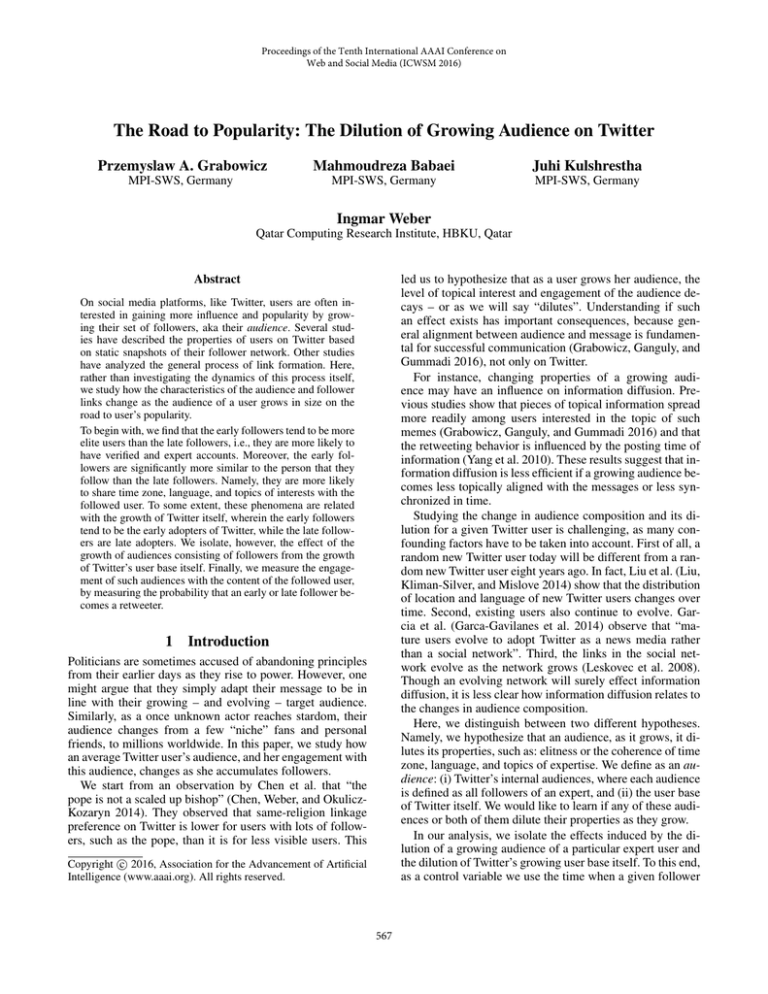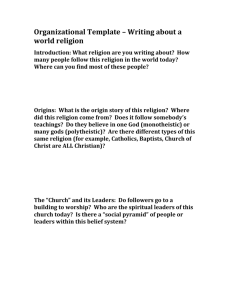
Proceedings of the Tenth International AAAI Conference on
Web and Social Media (ICWSM 2016)
The Road to Popularity: The Dilution of Growing Audience on Twitter
Przemyslaw A. Grabowicz
Mahmoudreza Babaei
Juhi Kulshrestha
MPI-SWS, Germany
MPI-SWS, Germany
MPI-SWS, Germany
Ingmar Weber
Qatar Computing Research Institute, HBKU, Qatar
led us to hypothesize that as a user grows her audience, the
level of topical interest and engagement of the audience decays – or as we will say “dilutes”. Understanding if such
an effect exists has important consequences, because general alignment between audience and message is fundamental for successful communication (Grabowicz, Ganguly, and
Gummadi 2016), not only on Twitter.
For instance, changing properties of a growing audience may have an influence on information diffusion. Previous studies show that pieces of topical information spread
more readily among users interested in the topic of such
memes (Grabowicz, Ganguly, and Gummadi 2016) and that
the retweeting behavior is influenced by the posting time of
information (Yang et al. 2010). These results suggest that information diffusion is less efficient if a growing audience becomes less topically aligned with the messages or less synchronized in time.
Studying the change in audience composition and its dilution for a given Twitter user is challenging, as many confounding factors have to be taken into account. First of all, a
random new Twitter user today will be different from a random new Twitter user eight years ago. In fact, Liu et al. (Liu,
Kliman-Silver, and Mislove 2014) show that the distribution
of location and language of new Twitter users changes over
time. Second, existing users also continue to evolve. Garcia et al. (Garca-Gavilanes et al. 2014) observe that “mature users evolve to adopt Twitter as a news media rather
than a social network”. Third, the links in the social network evolve as the network grows (Leskovec et al. 2008).
Though an evolving network will surely effect information
diffusion, it is less clear how information diffusion relates to
the changes in audience composition.
Here, we distinguish between two different hypotheses.
Namely, we hypothesize that an audience, as it grows, it dilutes its properties, such as: elitness or the coherence of time
zone, language, and topics of expertise. We define as an audience: (i) Twitter’s internal audiences, where each audience
is defined as all followers of an expert, and (ii) the user base
of Twitter itself. We would like to learn if any of these audiences or both of them dilute their properties as they grow.
In our analysis, we isolate the effects induced by the dilution of a growing audience of a particular expert user and
the dilution of Twitter’s growing user base itself. To this end,
as a control variable we use the time when a given follower
Abstract
On social media platforms, like Twitter, users are often interested in gaining more influence and popularity by growing their set of followers, aka their audience. Several studies have described the properties of users on Twitter based
on static snapshots of their follower network. Other studies
have analyzed the general process of link formation. Here,
rather than investigating the dynamics of this process itself,
we study how the characteristics of the audience and follower
links change as the audience of a user grows in size on the
road to user’s popularity.
To begin with, we find that the early followers tend to be more
elite users than the late followers, i.e., they are more likely to
have verified and expert accounts. Moreover, the early followers are significantly more similar to the person that they
follow than the late followers. Namely, they are more likely
to share time zone, language, and topics of interests with the
followed user. To some extent, these phenomena are related
with the growth of Twitter itself, wherein the early followers
tend to be the early adopters of Twitter, while the late followers are late adopters. We isolate, however, the effect of the
growth of audiences consisting of followers from the growth
of Twitter’s user base itself. Finally, we measure the engagement of such audiences with the content of the followed user,
by measuring the probability that an early or late follower becomes a retweeter.
1
Introduction
Politicians are sometimes accused of abandoning principles
from their earlier days as they rise to power. However, one
might argue that they simply adapt their message to be in
line with their growing – and evolving – target audience.
Similarly, as a once unknown actor reaches stardom, their
audience changes from a few “niche” fans and personal
friends, to millions worldwide. In this paper, we study how
an average Twitter user’s audience, and her engagement with
this audience, changes as she accumulates followers.
We start from an observation by Chen et al. that “the
pope is not a scaled up bishop” (Chen, Weber, and OkuliczKozaryn 2014). They observed that same-religion linkage
preference on Twitter is lower for users with lots of followers, such as the pope, than it is for less visible users. This
c 2016, Association for the Advancement of Artificial
Copyright Intelligence (www.aaai.org). All rights reserved.
567
joined Twitter, i.e., the age of that user in the system. This
allows us to measure both effects of the growing number of
followers and Twitter’s user base on the composition of such
audiences. We find that:
• As the number of followers grows for a given expert user,
the composition of these followers dilutes. We find examples of this rule in the eliteness of followers and their
topical coherence.
0.2 0.4 0.6 0.8
Percentile of followers
1.0
0.2
0.1
0.0
0.0
0.2
0.4
0.6
0.8
Percentile of followers
1.0
(B) Expertise
Figure 1: The eliteness of sub-groups of followers of equal
size ordered by the time of link formation from the earliest to
the latest for real (black circles) and reshuffled (red squares)
followers. The plot is prepared for each user separately and
then averaged over all users from our set of experts. The error bars are 95% confidence intervals computed on the set
of followers and averaged over experts; such estimate is an
upper bound of the error bars. The remaining plots are prepared in the same way.
Description of the dataset
In this work, we analyze followers of expert users. We define an expert as a user that was included in multiple Twitter lists (Ghosh et al. 2012).1 For each of the expert users,
we know the topics of their expertise as they have been explicitly “tagged” by the list curators. Also, we represent expertise of each user as a normalized topical distribution over
her topics of expertise (Kulshrestha et al. 2015). Expert users
tend to produce more high-quality content and less spam and
they are more engaged than random Twitter users (Ghosh et
al. 2013). We choose to focus on random expert users instead
of all users, due to these qualities.
In total, we identified around 1.6M experts in Twitter as
of November 2015. Note that users with many followers are
likely to be included in this set.2 For the purpose of this
study, we sample a set of 1K random expert users. More
specifically, we select random experts from five different
bins of the number of followers. Namely, we select 200 experts that each had 100 to 1K, 1K-10K, 10K-100K, 100K1M, or 1M-10M followers in the end of November 2015.
Then, using Twitter’s REST API, we retrieve all followers of our expert users and the profile information of these
followers. In total, we gather information about 241M users.
Furthermore, we collect all tweets of our expert users that
were posted during three months between September and
October 2015 and all retweets of these tweets, amounting to
1M tweets and 23M retweets.
3
0.01
0.3
(A) Verified
In what follows, we first describe the dataset that illustrates our findings. Then, we introduce the random shuffling
method that is used to distinguish between the growth of the
number of followers and Twitter’s user base (Section 3.1).
Next, we measure the properties of these growing audiences
(Section 3) and their engagement estimated as the fraction
of followers diffusing information (Section 3.3).
2
0.02
0.00
0.0
• The composition of Twitter’s user base also dilutes.
Namely, the eliteness of users joining Twitter drops and
so does their time zone and language coherence.
0.4
Fraction of experts
Fraction verified
0.03
3.1
The eliteness of followers
First, we quantify the eliteness of followers of our expert
users. To this end, we use two different metrics of eliteness
by checking whether (i) the accounts of followers are verified by Twitter3 and (ii) whether they are collectively tagged
as expert accounts (Ghosh et al. 2012). We aim to measure
how the eliteness of followers changes as the number of followers grows over time. To this end, we split the followers
of each expert user into ten chronological bins: the first bin
contains the 10% earliest followers, whereas the last bin contains the 10% latest followers. We name these chronological
bins as the recency of followers. Next, we average the measurements over followers in each bin, and then over our set
of expert users.
We find that the earlier followers tend to be more elite
than the later followers (Figure 1), both in the terms of verified and expert accounts. Later followers are around half
as likely to have verified accounts and over three times less
likely to be expert users (compare the leftmost and the rightmost black circles in Figure 1A and 1B).
We note here, that these results can be explained by at
least two processes: either (i) the dilution of growing audiences of followers or (ii) the dilution of Twitter’s user base
itself, because later followers are users who joined Twitter
more recently and soon after joining started forming their
follower links (Figure 2). To separate the impact of these
two related processes on our results, we randomly reshuffle all follower links of expert users while fixing the age of
follower users in the system. Namely, for each expert, every
follower is exchanged with a random follower of another expert, under the crucial constraint that an actual follower who
joined Twitter in year Y can only get replaced by a random
follower who also joined Twitter in year Y. Therefore, for
The dilution of growing audience
In this section, for each user from our expert set, we look at
the properties of their followers as a function of the recency
of these followers. This way, we measure how the early audiences differ from the later ones.
1
A list is a set of users tagged by the creator of the list. See
https://blog.twitter.com/2009/theres-a-list-for-that for details.
2
For comparison, Followerwonk listed 824k Twitter users
with at least 10,000 followers as of 5th of January 2016, see
https://moz.com/followerwonk/bio/?flmin=10000.
3
A verification badge is granted to accounts that correspond to authentic identities of individuals or brands. More at
https://support.twitter.com/articles/119135.
568
0.25
5
4
3
0.0
0.2
0.4
0.6
0.8
Percentile of followers
0.15
0.10
0.05
0.00
0.0
1.0
5.5
0.20
TZ offset [hours]
Same time zone
Age [years]
6
0.2 0.4 0.6 0.8
Percentile of followers
0.2
0.4
0.6
0.8
Percentile of followers
1.0
(B) Difference in TZ offset
Figure 3: Time zone match between a user and her followers
ordered from the earliest to the latest.
each given expert we preserve the distribution of ages of her
followers, up to variations within year Y. Furthermore, we
assume that these reshuffled links for each expert were created in the same chronological sequence as the real follower
links that got replaced. Thus, this reshuffling purposely preserves the correlation between age and recency of followers
(compare red and black lines in Figure 2), while destroying the correlations between recency and other properties
that are not implied by their correlation with age. In such
a reshuffled network, existence of a correlation between recency and a given property signifies that this correlation is
due to the age of followers in the whole Twitter system, instead of their recency among the given set of followers.
We plot the metrics of eliteness for the reshuffled followers as red squares in Figure 1. Noticeably, the values of eliteness drop with the recency of reshuffled followers in a similar way to real followers, so the dilution of eliteness of the
growing user base of Twitter is present. In other words, it is
likely that “tech-savy” experts joined Twitter early on and
since that time the user base of Twitter is diluting to a more
casual population. In the case of verified accounts, we do
not find evidence for the dilution among followers of a user
(curves in Figure 1A are nearly parallel). However, in the
case of expertise, we find that the fraction of expert users
drops down faster with the recency among real followers
than among reshuffled followers (the two curves meet at the
rightmost point in Figure 1B, but the black curve is steeper
than the red curve). This finding means, that the fraction of
expert users among followers drops down with the recency
of these followers, providing an evidence for the dilution of
expertise among growing audience at the level of followers
of individual expert users.
3.2
3.5
2.5
0.0
1.0
(A) TZ match
Figure 2: The account’s age for real (black circles) and
reshuffled (red squares) followers versus their recency.
4.5
0.6
Topical similarity
Same language
0.9
0.8
0.7
0.6
0.5
0.0
0.2
0.4
0.6
0.8
Percentile of followers
(A) Language
1.0
0.4
0.2
0.0
0.0
0.2
0.4
0.6
0.8
Percentile of followers
1.0
(B) Topic
Figure 4: The language match and the topical similarity between a user and her followers ordered from the earliest to
the latest.
for the latest followers; that is a nearly 20% increase in the
difference between the time zones. An increased desynchronization of time zones may lead to a coverage bias, if the
experts produce certain type of content in the evening, when
some of their followers are already asleep.
Also, we note that the earlier followers are more likely
than the later followers to use the same language as the person they follow (Figure 4A). This result is followed by a
related finding showing that the earlier followers are more
likely to share topics of expertise with the person they follow (Figure 4B). We compute the topical similarity of expertise between users as the cosine similarity of their expertise
distributions (Kulshrestha et al. 2015). Note that this calculation can be done only for followers who are experts themselves, for whom expertise distributions are known.
Again, we compare these results against the results for
the randomly shuffled followers. Interestingly, the dilution
of language is more pronounced for the reshuffled followers.
This is an intriguing result that can be explained by the fact
that initially almost all tweets were in English, while nowadays there exist large non-English communities on Twitter (Liu, Kliman-Silver, and Mislove 2014). On the other
hand, we note that the topical similarity between an expert
and her followers is twice larger than between the user and
her reshuffled followers (compare the black and red lines in
Figure 4B). Most importantly, the topical alignment of Twitter’s user base does not decrease, while it visibly decreases
for the growing audiences of followers (compare the slopes
Time zone, language, and topical congruence
Next, we measure audience characteristics and compare
them to the expert they follow. To this end, we extract the
time zone and the language of each user from the selfreported fields specified by each user in their profile.
Having this information, we measure if the expert and
their audience are in the same time zone (Figure 3) and if
they report the same language (Figure 4). We find that the
earlier followers are more likely to be in the same time zone
as the person they follow (Figure 3). The average absolute
difference between the time zone of the expert and her followers is 3 hours for the earliest followers and above 3.5
569
further rigorous studies of the dynamics of the latent properties of users, such as the language or topics of expertise,
shall explore this question.
Finally, we note that our measurements are platformspecific. Thus, is the law of dilution of organically growing
audiences present in other systems, also offline social collectives? Furthermore, what is the importance of this law with
respect to recommender systems? Oftentimes, recommender
systems suggest content that is topically aligned to our interests. What minimalist recommender system leads to the
dilution of growing audiences? Addressing these questions
will shed more light on this intriguing phenomenon.
5
Tweets per day
Fraction of retweeters
0.035
0.025
0.015
0.005
0.0
0.2 0.4 0.6 0.8
Percentile of followers
1.0
4
3
2
0.0
0.2
0.4
0.6
0.8
Percentile of followers
1.0
Figure 5: (A) The fraction of retweeters among followers
ordered from the earliest to the latest. (B) The average number of tweets produced per day by a follower versus the sequence of followers ordered from the earliest to the latest.
References
Chen, L.; Weber, I.; and Okulicz-Kozaryn, A. 2014. U.s.
religious landscape on twitter. In SocInfo, 544–560.
Garca-Gavilanes, R.; Kaltenbrunner, A.; Sez-Trumper, D.;
Baeza-Yates, R.; Aragn, P.; and Laniado, D. 2014. Who are
my audiences? a study of the evolution of target audiences
in microblogs. In SocInfo, 561–572.
Ghosh, S.; Sharma, N.; Benevenuto, F.; Ganguly, N.; and
Gummadi, K. 2012. Cognos: Crowdsourcing Search for
Topic Experts in Microblogs. In SIGIR, 575–590.
Ghosh, S.; Zafar, M. B.; Bhattacharya, P.; Sharma, N.; Ganguly, N.; and Gummadi, K. 2013. On sampling the wisdom
of crowds. In Proc. 22nd ACM Int. Conf. Conf. Inf. Knowl.
Manag. - CIKM ’13, 1739–1744. New York, New York,
USA: ACM Press.
Grabowicz, P.; Ganguly, N.; and Gummadi, K. P. 2016.
Distinguishing between Topical and Non-topical Information Diffusion Mechanisms in Social Media. ICWSM ’16:
Proceedings of the 10th International AAAI Conference on
Webl and Social Media.
Kulshrestha, J.; Zafar, M. B.; Noboa, L. E.; Gummadi, K. P.;
and Ghosh, S. 2015. Characterizing Information Diets of
Social Media Users. In ICWSM.
Leskovec, J.; Backstrom, L.; Kumar, R.; and Tomkins, A.
2008. Microscopic evolution of social networks. In Proceeding 14th ACM SIGKDD Int. Conf. Knowl. Discov. data
Min. - KDD ’08, 462–470. Las Vegas, Nevada, USA: ACM.
Liu, Y.; Kliman-Silver, C.; and Mislove, A. 2014. The
Tweets They are a-Changin: Evolution of Twitter Users and
Behavior. Proc. Eighth Int. AAAI Conf. Weblogs Soc. Media
305–314.
Yang, Z.; Guo, J.; Cai, K.; Tang, J.; Li, J.; Zhang, L.; and
Su, Z. 2010. Understanding Retweeting Behaviors in Social
Networks. Idea 1633–1636.
of red and black lines in Figure 4B, respectively), suggesting that the dilution is present at the level of followers of
individual users, but it is not at the level of whole Twitter.
3.3
The engagement of followers
Finally, we would like to understand how the diluted properties of a growing audience influence engagement metrics.
Among such metrics we distinguish different types of interactions between a follower and the expert that they follow,
for instance: retweets, favorites, replies. Here, we focus on
the results for retweets.
We measure the engagement of followers with respect
to the user that they follow, by measuring the fraction
of retweeters among the followers of given recency (Figure 5A). This fraction initially drops by around 30% for
early followers and then it grows 3-fold for late followers.
On the one hand, we expect that the fraction of retweeters
among early followers should be higher, because they are
more synchronized with the person that they follow in terms
of time zone, language, and topics of expertise. On the other
hand, the tweeting rate of the followers increases with their
recency (Figure 5B), because some users get bored and cease
using Twitter, while other users are spam bots. This may be
the reason why the fraction of retweeters increases with the
recency of the followers.
4
Discussion
Our results show that the composition of growing audiences
tends to get diluted. First, we find that the eliteness of followers of an expert and their topical coherence decreases
with their recency. Second, we show that the composition
of Twitter’s user base also dilutes. For example, the eliteness and the time zone and language congruence of the users
joining Twitter drops with their recency. We hypothesize that
these phenomena are the effect of a common dilution process that happens for growing audiences.
Future studies may want to understand how global evolving trends are affected and interact with the rule of dilution
of growing audiences. Furthermore, it is unclear what is the
impact of the growing and diluted audiences for information
diffusion. We show initial measurements in this respect, but
570








